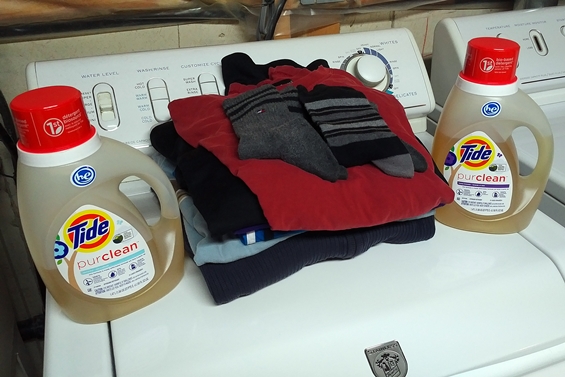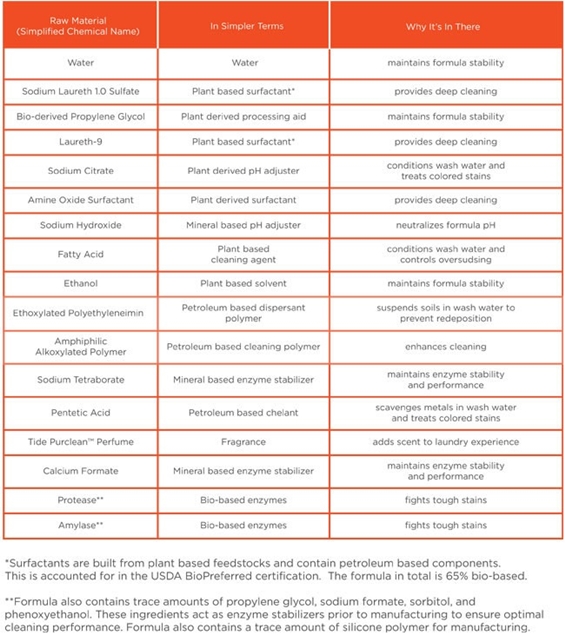It’s always been ironic as to how we dirty our environment through the process of cleaning our laundry.
Keeping our clothes and other laundered items clean is and will always be necessary for a variety of reasons. What is becoming less necessary however is the need to create detergents that contain ingredients which one way or another are harmful to our environment.
What has always been the challenge for producers of detergent is how to develop a formula that combines cleaning power with environmental responsibility. It’s possible to buy all-natural detergents, but my experience with them has always been disappointing when it came to actually removing stains or cleaning. Conversely, detergents with the proven ability to clean include among their ingredients items derived from petroleum and other harmful sources.
However according to Procter & Gamble, they have developed a new formulation of Tide that strikes the right balance and goes where no other detergents have gone before. According to P&G, Tide Purclean is the first bio-based detergent with the trusted cleaning power of Tide. With 65% bio-based ingredients, as certified by the USDA BioPreferred program, Tide Purclean aims to set the performance standard for natural detergents and in turn bring more consumers to the natural detergent category.
With the launch of Tide Purclean in Canada, I was happy to accept an opportunity to work with Procter & Gamble in order to learn more about the product and conduct a review of it myself. As someone who has been doing my own laundry for decades, I know more than enough about what makes a good detergent. For added measure though I did also recruit my wife to try out the provided samples as well given that she is largely entrusted to handle the laundry for the rest of the household, including our four active and often messy children.
A BRIEF HISTORY OF SOAP AND DETERGENT
The use of soap can be traced all the way back to ancient times. Used for a variety of purposes, soap was something many families made themselves. Natural soap however has limited effectiveness when used with hard-water, which is water rich in natural minerals such as calcium, magnesium, iron, and manganese. To counter the ineffectiveness of natural soap in hardened water, combined with the growth and popularity of washing machines in the early-to-mid twentieth century, detergents (or artificial soaps) were developed.
The basic purpose of soap and detergents in general is to first adhere to stains found on clothing and then to pull them away in water leaving the laundered item clean. With the development of detergents, the opportunity to enhance formulas arose and over time additives were included to increase the stain-removing power, better react with hard water, protect washing machines from corrosion, protect natural fibres and even provide fragrance to the entire process.
EARLY ENVIRONMENTAL CHANGES TO DETERGENTS
In developing more complex detergent formulas, a number of the enhancements were due to additives derived from products such as oil. These additives, along with others such as phosphates were identified as having negative environmental impacts which environmentalists felt needed to be addressed.
Phosphate builders found in detergents added large amounts of phosphorous compounds to waterways. Acting as a fertilizer, the phosphorus stimulated the growth of algae, and these unnaturally large crops of algae significantly depleted the amount of dissolved oxygen in water. This decrease in free oxygen harmed other marine life, thus threatening to disrupt normal ecological patterns.
The realization of this problem, led to the development of formulas which are phosphate free and is all but the norm amongst modern detergent formulas today. What remains however, is the need to address how to rid other harmful additives, while still being able to provide a product that is effective and cleaning clothing and other items.
TAKING DETERGENT TO A NEW ENVIRONMENTAL LEVEL
According to P&G, Tide Purclean is made with 65% Bio-based ingredients as certified by the USDA bio-preferred program. Bio-based products are derived from plants and other renewable agricultural, marine, and forestry materials. Bio-based products provide an alternative to conventional petroleum-derived products and include a diverse range of offerings. Bio-based products, from a BioPreferred Program perspective, do not include fuels, food, or animal feed. Biobased products also help increase the use of renewable resources while decreasing use of non-renewable resources, such as petroleum.

The environmental impacts of manufactured items such as Tide Purclean go beyond the formulas themselves. The manufacturing of products like Tide Purclean requires a fair amount of energy consumption, which is a reality that P&G seems to be both conscious of and committed to improving.
It is claimed that Tide Purclean is made with 100% renewable wind-power electricity. It’s a claim that some would interpret as there being a wind farm located immediately beside and directly fed into the production plant. However, this isn’t necessarily the case, and something I feel is in need of a better explanation.
Last year, P&G announced that it would partner with EDF Renewable Energy to build a wind farm in Texas which would generate 370,000 MW of renewable energy per year when fully completed – a date scheduled for late this year. The goal through this endeavor is to generate at least the equivalent power use, if not more than would meet the electricity demands for all of P&G’s North American Fabric & Home Care plants, where brands such as Tide, Gain, Downy, Dawn, Cascade, Febreze, and Mr. Clean are produced.
As renewable energy is indistinguishable from any other energy source once fed into the electricity grid, it’s difficult to know for certain that energy used in any one manufacturing facility comes specifically from renewably generated sources – that is unless directly connected to such a source. As this is not the case at the moment, I find it challenging to assertively make the claim that Tide Purclean is made using 100% wind energy. What is fair to say, however is that any energy use attributed to the manufacturing of Tide Purclean, regardless of its source or origin is being off-set by the generating and injecting of clean, renewable power into the electrical grid.
Given the well-established infrastructure and manufacturing logistics of a large company such as P&G, it may be unreasonable at this stage to expect wind turbines or solar arrays to be directly connected to each facility. As plants become obsolete and new facilities are required this may yet become the new norm for P&G as well as all other manufacturers. In the interim, however this is clearly a positive starting point and one that can only improve as the entire energy grid becomes more sustainable and less harmful to our climate and environment as a whole.
Once the product formula is developed and then manufactured, a final step then is to package it. With Tide Purclean, the bottles used to hold the formula are made with 25% post-consumer recycled materials, and themselves are 100% fully recyclable. The benchmark of 25% and not higher is largely established due to the limitation of available post-consumer recycled materials to source from and not necessarily any technical limitations.
BUT DOES TIDE PURCLEAN ACTUALLY WORK?
For as much as I felt the need to provide a backgrounder on laundry detergent and how a product like Tide Purclean actually fills a presumed void in effective laundry detergents with a minimal environmental footprint, it’s also just as important to offer an opinion as to whether it actually works. That is…does it clean clothes as good as regular Tide?
After using the provided samples of Tide Purclean on approximately a dozen loads of laundry completed by both my wife and myself, the easiest answer to offer…is yes.
Our collective experience has concluded that by using Tide Purclean, there is no discernable reduction in effectiveness at all. While I did have one experience with a deeply set-in food stain on a T-shirt belonging to my son where the stain did not come out entirely, my wife and I were both of he opinion that this stain was unlikely to come out no matter what product was used.
An interesting observation from my wife was that when she washed her Yoga-type pants in regular detergent, she often noticed a slight residue which often required an extra rinse. However, when she washed the pants in Tide Purclean, the residue was not there.
Tide Purclean is available in both an unscented as well as Honey Lavender scented version. While I’m not typically fond of scented detergents, I found the Honey Lavender to not be overpowering and even somewhat pleasant.
BOTTOM LINE
My approach to environmentalism and the need for overall societal change towards a more sustainable standard of living has always been rooted in pragmatic, yet progressive thinking. For as much as we need to make some rapid and fundamental challenges to the way we produce, consume and even think about how we live our lives, the reality is that it has to be tempered somewhat by the limits society will accept and technology will create. Laundry detergent is a prime example of a consumable product that modern society views as both fundamental and necessary. While attitudes continue to change where sustainability is concerned, people still need to know that any detergent they use will ultimately do what it is expected to do – that is clean their clothes and other similar items.
Tide Purclean proved to me that it’s very effective at meeting the demands of my family where laundry is concerned. The environmentalist in me is pleased about the progressive steps being made with this product, but at the same time I don’t want to see P&G resting on their laurels just yet. I know that improvements can still be made with regard to all aspects of it’s development, production and distribution and the good thing is that based on my research and contact with individuals on the product development team at P&G, they appear to feel the same way.
Tide Purclean is a step in the right direction. There are many steps to go of course, but in the interim I take solace in knowing that dealing with the laundry demands of a large and active family can now be done effectively and more sustainably than it has been done in the past.
DISCLAIMER: The above is a sponsored post in collaboration with Porter Novelli Canada, a division of Omnicom Canada Corp for the Tide Purclean campaign. All editorial opinions expressed, however remain solely those of the author and were not subject to approval from the sponsor prior to publishing.




My yide pirclran becomes lumpy at the end of the bottle. It’s happened 3 times. Has the laundry detergent gone bad? Can I still use it if this happens?
* tide purclean
Sorry for the typo